OUR NAME
THE MEANING OF
HARTWELL
I.
ANCIENT
SYMBOL
OF THE CHURCH
Since ancient times, Christian art has depicted harts (stags) alongside wells and fountains, known as “hart-wells,” as powerful symbols of Christ. These symbolic representations not only signify the waters of salvation and baptism, but also evoke the imagery of the river flowing from Eden (Genesis 2:10) and the throne of God (Revelation 22:1) to bring fruitfulness and healing to the nations.
II.
NAMESAKE OF
CHRISTIAN EXEMPLARS
Hartwell University® (HU) deeply reveres exceptional believers who are intricately connected to this institution, either through their namesakes or other significant associations. These exemplary Christians bestow a heightened sense of depth and purpose to the profound significance of our name.
III.
EPITHET OF
HISTORIC LANDMARKS
The interconnectedness of history is seen in the epic stories of Hartwell Tavern and Hartwell House. From the pivotal role of Hartwell Tavern in Paul Revere’s ride to the “shot heard round the world” and the subsequent exile of King Louis XVIII at Hartwell House, these events demonstrate how seemingly small actions can have far-reaching consequences.
I. CHURCH SYMBOLISM
“He makes my feet like the feet of a deer; he causes me to stand on the heights” (Psalm 18:33).
“As a deer pants for flowing streams,so pants my soul for you, O God” (Psalm 42:1).
Since the time of the early Church, harts (stags) with wells and fountains (“hart-wells”) have been depicted in Christian art as symbols of Christ. They also represent the waters of salvation, baptism, and the river that flowed from Eden and the throne of God in Genesis 2:10 and Revelation 22:1.
Hartwell literally means “stag spring” or “deer fountain.” A “hart-well” is a “spring or stream frequented by deer.” In Christian symbolism, deer represent those who long after and pursue God. They are the ones who “stand on the heights” (Ps. 18:33), seated with Christ in heavenly places (Eph. 2:6).
The mosaic at the top of this page is from Carthage and pictures a hart-well dating to the 4th or 5th century A.D. Another example of this symbol can be seen in the Mosaic at the baptistery of the Plaošnik Basilica in North Macedonia, which dates to the same time period. Other hart-wells are seen at places like the Small Basilica of Philippopolis and many additional locations like Roman catacombs and churches.
Jean-Jacques Lequeu, an 18th-century French architect and draftsman, designed a unique baptismal font that symbolically links the eternal life-giving water with the sacrificial bloodshed of Jesus Christ. The altar subtly features instruments of the Passion, while stags’ heads crown the apse above the font, referencing Psalm 42. His work is possibly a tribute, in part, to mosaics like the Apse Mosaic (featured below) from a Roman basilica dating to the High Middle Ages.
WATERS
OF SALVATION
The mosaic pictured here is at the Basilica of San Clemente in Rome and named “The Fountain of Life.” It portrays Jesus on the Cross from which flows streams of water. Deer drink from the spring, representing the spiritual nourishment in Christ who is the source of all life and salvation.
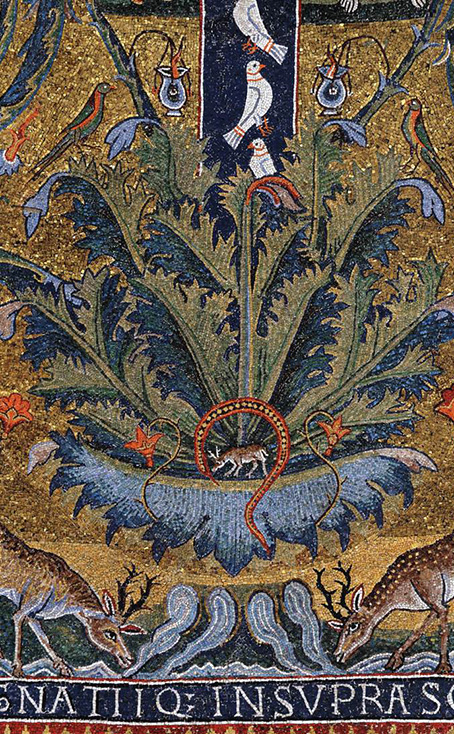
II. CHRISTIAN
EXEMPLARS
In addition to the Church symbolism noted above, the combination of the inspiring figures below enhances the University’s representation of missionary zeal, scholarly pursuits, and most importantly, outstanding character that is based in relationship to Christ and the biblical principles that have made Western society great.
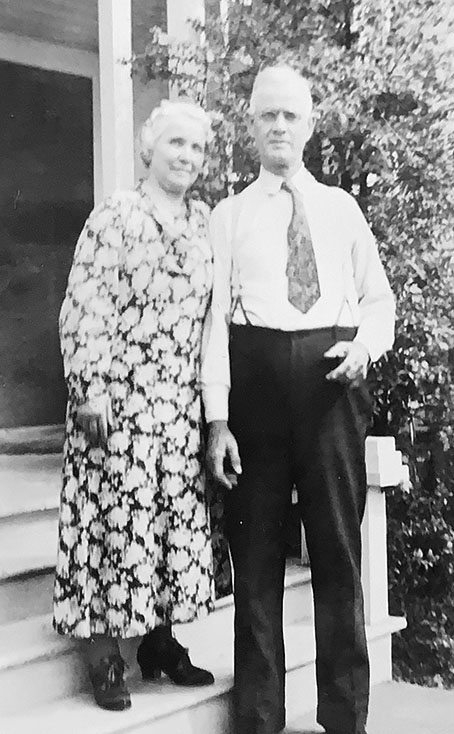
PRAYER & PHILANTHROPY
THE HARTERS
The global impact of Ralph & Clara Harter is still seen through organizations like Ethnos 360 (formerly New Tribes Mission), which their daughter and son-in-law founded. These loving parents provided substantial prayer and financial backing for epic endeavors like this.
Ralph and Clara Harter
In the Hartwell University name, a special nod is given to Ralph and Clara Harter, maternal great grandparents of Paul Snyder (HU’s co-founder and chairman). Ralph and Clara were dynamic Christians who raised three brilliant daughters (Doris, Vivian, and Cherrill) in the fear of the Lord. They held a strong belief in education. Ralph attended Stanford University and later made sure each of his daughters had the best schooling possible (Vivian graduated from Stanford in the 1920’s with an M.S. in Education).
A dynamic evangelist, Clara would take her daughters to sing and pray while she preached the Gospel of salvation to lost souls in front of saloons and anywhere else she could draw a crowd. Drunks would become sober, repent of their sins, and accept Jesus. The sick would often be healed as Clara prayed for them. Her daughter, Cherrill, would play the pump organ. It would often sink into the mud, but she would play on and watch God move as her mother preached. She learned all about the necessity and power of the Gospel and prayer while she ministered with her mom. Clara and Ralph planted seeds that would result in a worldwide harvest.
They exemplified the biblical principle of “storing treasures in heaven” (Matthew 6:20) through their impactful giving to missions. The Harters left a profound global impact that endures today through organizations such as Ethnos 360 (formerly New Tribes Mission), which was founded in 1942 by their daughter and son-in-law, Cherrill and Paul Fleming, with significant prayer and financial backing from Clara and Ralph. Hartwell University, as well, is a beneficiary of their loving legacy.
The Harter family’s ancestral roots can be traced back to Hart, Austria, where a majestic waterfall frequented by deer continues to grace the land. The name “Hartwell” not only pays homage to the Harter family heritage but also encompasses the University’s deep religious symbolism.
DEVOTED TO MISSIONS
CHARLES HARTWELL
Hartwell dedicated his life to spreading Christianity in China. He translated a significant portion of the New Testament into Fuzhou, authored textbooks, started hospitals, and more. His family also played a significant role in the American Revolution.
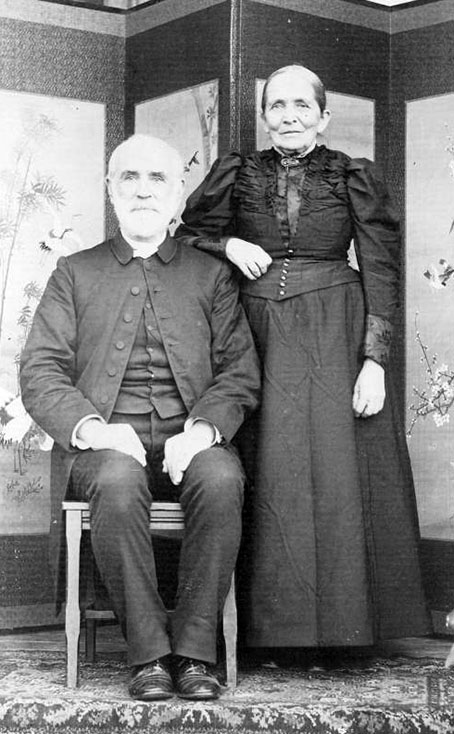
Charles Hartwell
Hartwell University finds profound inspiration and draws meaning from the lives of remarkable individuals, such as Charles Hartwell, an unwavering missionary and Bible translator who dedicated his life to spreading the Gospel. Charles Hartwell, born on December 19, 1825, in Lincoln, Massachusetts, received his theological education at Amherst College after attending Westford Academy. Ordained on October 13, 1852, he embarked on a missionary journey to China under the American Board of Commissioners for Foreign Missions (ABCFM). Arriving in Hong Kong on April 16, 1853, Hartwell was stationed in Fuzhou for the remainder of his life, apart from three visits to the United States.
Charles Hartwell, esteemed for his expertise in Chinese history, language, and culture, was fluent in the Fuzhou dialect and played a vital role in its romanization. Alongside his preaching, he undertook the significant task of translating a substantial portion of the New Testament into Fuzhou. Charles Hartwell also authored educational textbooks, contributed to journals, and wrote on meteorology. The commemoration of his fiftieth anniversary in China took place in 1903, and he peacefully passed away on January 30, 1905, in Fuzhou. Throughout his life, Charles Hartwell was married twice, first to Lucy E. Stearns and later to Hannah Louisa Plimpton Peet Hartwell. Continuing the family’s legacy, his daughter, Emily Susan Hartwell, carried on his missionary work in China until 1937.
One fascinating tidbit about Charles’ family is that his great-grandfather owned Hartwell Tavern in Lincoln, Massachusetts. The tavern played a significant role in American history, as well as the ensuing world history from the “shot heard round the world” at the battles of Lexington and Concord. Charles’ grandmother was a revolutionary heroine who relayed the alert to the Minutemen after Paul Revere was captured on his famous midnight ride.
The profound impact of Charles Hartwell’s missionary endeavors and steadfast commitment to sharing the Gospel make him a deserving figure to be honored in the name of Hartwell University. The University also recognizes Emily Susan Hartwell, his devoted daughter, who faithfully continued the Hartwell missionary legacy in China. Their unwavering dedication and tireless efforts serve as an enduring example to us in our commitment to spreading knowledge, compassion, and the Christian faith.
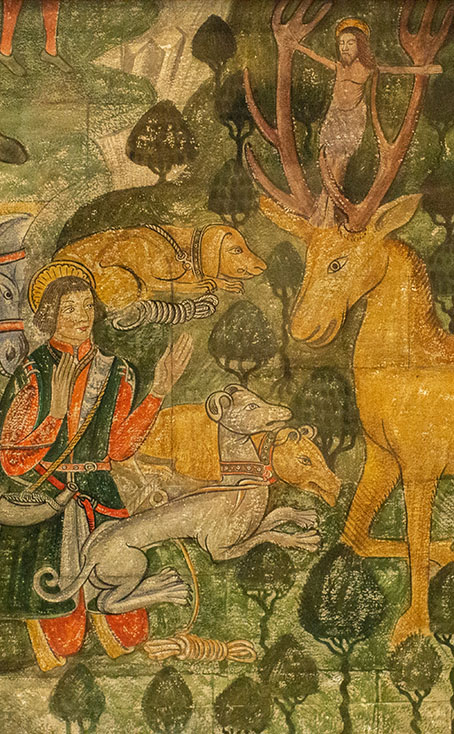
UNWAVERING MARTYR
EUSTACE OF ROME
Associated with the stag, Eustace was a Roman general turned Christian martyr in the 2nd century. Facing persecution, he embraced his faith and is remembered for his unwavering devotion and martyrdom for Christ.
Eustace of Rome
Eustace of Rome, also known as Eustachius, was a Christian who lived in the 2nd century. He is often referred to as Eustace the Martyr due to his eventual martyrdom for his faith. Eustace adds further spiritual depth and significance to the meaning of Hartwell University, symbolized by the hart (stag). He is revered as a saint by Catholics, Anglicans, and Eastern Orthodox Christians. His story and devotion have resonated across different branches of the faith, and he is honored throughout many denominations.
According to Christian tradition, Eustace, a Roman general during the reign of Emperor Trajan, had a profound encounter with a stag bearing a crucifix between its antlers while hunting. Moved by this miraculous sight and the voice of Jesus calling him to convert, Eustace and his family embraced Christianity. However, their faith brought them great suffering as Emperor Trajan demanded they renunciate Christ. Eustace’s refusal led to their separation, torture, and eventual martyrdom. He is often depicted in art with the stag and crucifix, symbolizing his encounter with God.
The following video from Canterbury Cathedral captures the meekness and humility seen in Eustace (indeed, in Christ) that makes his story important to the ethos of Hartwell University.
RENOWNED SCHOLAR & APOLOGIST
THOMAS HARTWELL HORNE
Thomas Hartwell Horne (1780-1862) revolutionized biblical studies with his work, An Introduction to the Critical Study and Knowledge of the Holy Scriptures (1818). His comprehensive approach made him a leading biblical scholar, shaping the field and influencing future theology.
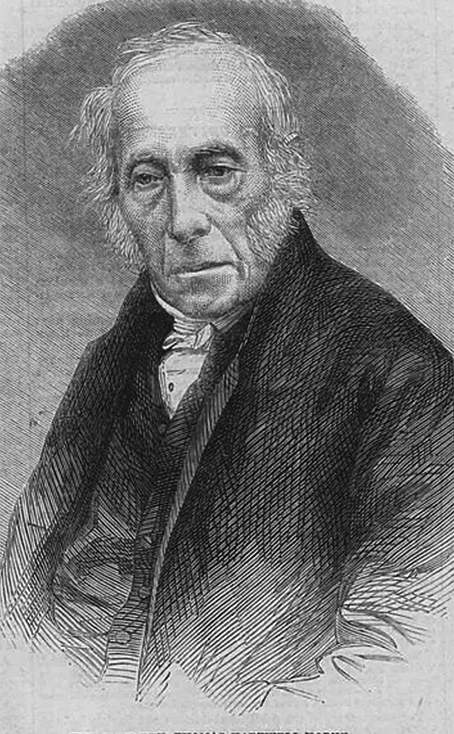
Thomas Hartwell Horne
“Ignorance of the scriptures is the root of all error.”
Thomas Hartwell Horne (1780-1862) was a prominent British theologian and scholar whose contributions to biblical studies left an indelible mark on the field. Born in London, Horne initially pursued a career in law but eventually redirected his focus towards theology. Ordained as a minister, he dedicated his life to the study and interpretation of the Bible.
Horne’s most influential work, An Introduction to the Critical Study and Knowledge of the Holy Scriptures, published in 1818, garnered widespread acclaim and transformed the landscape of biblical scholarship. The book offered a comprehensive examination of various aspects of the Bible, including authorship, historical context, and textual accuracy. Horne’s meticulous research and analytical approach set a new standard in biblical criticism, providing readers with valuable insights into the Scriptures.
One of Horne’s key contributions was his emphasis on the critical study of the Bible. He recognized the importance of historical context, linguistic analysis, and literary genres in understanding the intended meaning of biblical texts. By advocating for a balanced approach that incorporated both faith and reason, he sought to bridge the gap between skeptical objections and religious belief. His work aimed to equip scholars, ministers, and laypeople alike with the tools needed to engage with the Scriptures in a thoughtful and informed manner.
Horne’s impact extended beyond the publication of his magnum opus. He served as a catalyst for subsequent generations of biblical scholars, laying the foundation for further advancements in the field. His emphasis on rigorous research, scholarly integrity, and a holistic understanding of the Bible resonated with many, shaping the trajectory of theological scholarship for years to come.
Thomas Hartwell Horne embodies the intellectual and spiritual legacy that Hartwell University embraces. His work endures as a testament to his profound dedication to the study of scripture and his influential contributions to biblical scholarship. Horne continues to inspire scholars, theologians, and seekers of truth, reminding us of the richness and depth of the Holy Scriptures and the importance of engaging with them critically and faithfully.

TRANSFORMED SEEKER
HUBERT OF BELGIUM
Legend tells us that Hubert (656-727) had a life-altering encounter with a stag bearing a crucifix. This led to his conversion and he left a life of wealth for ministry. His story emphasizes the power of divine encounters and our responsibility to all of creation.
Hubert of Belgium
In the 7th century, Saint Hubertus, born as Hubert of Belgium, lived a privileged life until a life-altering event occurred during a hunting expedition. He witnessed a remarkable vision—a majestic stag carrying a crucifix between its antlers. This divine encounter led him to embrace Christianity, renounce his former luxuries, and dedicate himself to God’s service.
The stag holds deep symbolism in Hubert’s life. Known for its grace, swiftness, and keen senses, the creature was a familiar sight in the forests where Hubert pursued his hunting activities. In Christian tradition, the stag represents spiritual longing and the pursuit of holiness. The stag’s appearance with the crucifix between its antlers symbolized divine intervention and Hubert’s profound conversion. He is hailed by Catholics as the patron saint of hunters.
Hubert’s encounter with the sacred stag and subsequent conversion serve as powerful symbols of divine intervention and personal transformation. The stag, representing the pursuit of holiness, remains an enduring emblem of Hubert’s spiritual journey. Reflecting on his life, the stag’s symbolism, and his broader legacy, we are reminded of the potential for spiritual awakening and our duty to respect and protect the natural world. These character traits make his story a prime parable for Hartwell University students and faculty.
AUSTERE HUMILITY
GILES OF PROVENCE
Giles (650-710) lived a life of solitude and prayer, exemplifying austere humility and selfless compassion. His legacy teaches the transformative power of simplicity and service to others, inspiring us to prioritize the spiritual care and well-being of those in need.

Giles of Provence
Known to Catholics, Anglicans, and the Greek Orthodox as Saint Giles, Giles of Provence is a revered figure in Christian history. He exemplified the moral values of simplicity, humility, and selflessness. Born in 7th century Greece, Giles chose a life of solitude and prayer in the forests of France. Despite his desire for seclusion, he became known for his spiritual gift of healing, attracting visitors from all walks of life.
The moral of his life lies in his unwavering commitment to self-sacrifice and service. He shunned material possessions and fame, embodying the belief that true fulfillment is found in devotion to God and the well-being of others.
The deer (or hind) is symbolically associated with Giles because of an incident during his hermitage. While living in the forest, a wounded deer sought refuge in his hermitage. Showing compassion, Giles tended to its injuries and nursed it back to health. The deer became a loyal companion, accompanying him on his spiritual journey.
The symbol of the deer represents Giles’s kindness and his connection with nature. It serves as a reminder of his selfless acts and his gift to bring healing to both humans and animals. Through his life and symbol, Giles of Provence inspires us at Hartwell University to embrace humble simplicity, practice compassion, and prioritize service to others.
III. HISTORIC LANDMARKS
Hartwell Tavern (Lincoln, Massachusetts)
Hartwell House (Buckinghamshire, South England)
Hartwell Tavern in Lincoln, MA, played a crucial role as a relay point during Paul Revere’s midnight ride, leading to the victorious battles of Lexington and Concord, the first battles of the American Revolution. The famous “shot heard round the world” from this conflict not only resulted in American independence but also sparked revolution in France and elsewhere.
Interestingly, the chain of events surrounding Hartwell Tavern in Massachusetts eventually led to the exile of King Louis XVIII at Hartwell House in South England, showcasing the interconnectedness of global historical events and the significant impact seemingly insignificant individuals (such as Violet Thayer noted below) can have.

RELIC OF FREEDOM
HARTWELL TAVERN
This national landmark played a pivotal role during Paul Revere’s midnight ride and the first battles of the American Revolution. Its significance lies in being a crucial relay point that helped warn and mobilize the local militia against the advancing British troops.
The Moral of Hartwell Tavern
The moral of the story surrounding Hartwell Tavern is that seemingly ordinary places and individuals can have a profound impact on history. Despite its humble appearance, Hartwell Tavern became a crucial relay point during a pivotal moment in the American Revolution. The events that unfolded there, including the shot heard round the world, shaped the destiny of nations and sparked revolutions. This highlights the importance of recognizing the significance of seemingly insignificant people and locations, reminding us that history is often driven by the collective actions of ordinary individuals who play extraordinary roles in shaping the course of events.
FAITHFUL
IN THE LITTLE THINGS
VIOLET THAYER
Born a slave, Violet is believed to have passed the torch of freedom from Hartwell Tavern on the night of Paul Revere’s all-important ride. We learn from her that small and faithful acts can turn the tide, break chains, and make a better world.
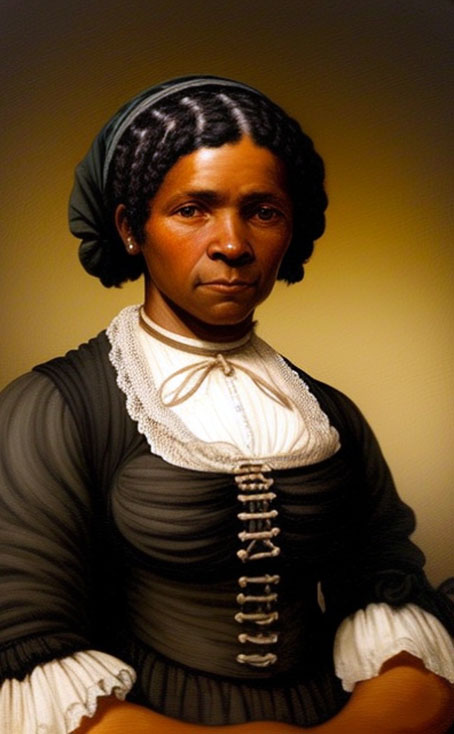
Violet Thayer
The true story of Paul Revere’s midnight ride on April 19, 1775, is somewhat obscured by the passage of time and reliance on second-hand oral accounts. While the details surrounding Violet’s involvement remain a mystery, we do know that she resided at Hartwell Tavern when Paul Revere was captured nearby. He had already warned John Hancock and Samuel Adams in Lexington of the approaching British. Revere and William Dawes set out from there on separate routes toward Concord (where a massive supply of patriot munitions was being stockpiled) to warn the Minutemen. Upon rendezvousing, they met a young Dr. Samuel Prescott who was out romancing his sweetheart. All three riders were together when Revere was captured. Dawes was apparently chased and escaped, but lost his mount. Prescott, however, managed to evade capture by leaping over a stone wall on his horse. Through cover of brush and swampland, he emerged near Hartwell Tavern to inform the patriots there before continuing on to Concord, spreading the warning along the way.
It is said that Violet was sent from the tavern to the Hartwell farmhouse to alert Samuel and Mary Hartwell, who were likely asleep at the time. Violet is believed to have cared for their baby and toddlers while Samuel and Mary hurried off. Samuel, a gunsmith and sergeant with the Lincoln Minutemen, had preparations to make for battle, while Mary is said to have relayed the alarm to their neighbor, Captain William Smith (brother of Abigail Adams), who sounded the town bells and rallied his troops.
The Minutemen reached the Old North Bridge in time to confront and repel the British forces at Lexington and Concord, the opening battles of the Revolution. Captain Smith’s company was the first to arrive in Concord and the initial shot fired at the bridge there became known as the “shot heard round the world.” Upon the British retreat, Lincoln (including Hartwell Tavern) is where the enemy began to run out of ammo and the largest number of casualties was taken there. Tyrannies near and far have fallen as a result of that day.
Violet’s apparent role in relaying the message and caring for the children may seem small, but it was crucial. Had she failed, it could have been the end of the American Revolution before it really began. This was the debut. When Violet was called to center stage on opening night in the theater of war, she performed beautifully. Her contribution, however seemingly insignificant, is highly esteemed and honored by Hartwell University. Her faithfulness in the little things (Luke 16:10) makes her one of the inspiring heroes in the story of Hartwell Tavern and the American Revolution.
“Igniting Freedom’s Light”
In shadows cast by chains, young Violet did arise, Born a slave, her spirit fierce, she sought to claim the skies. No place assigned but servitude, her worth unrecognized, Yet destiny had other plans, where courage harmonized.
With tireless hands and gentle heart, she toiled day and night, An unseen figure in the dark, veiled by oppressive plight. But fate’s design was intricate, weaving a grand decree, For Violet held a secret key to set the people free.
Amidst the whispers of unrest, where liberty took hold, She played a part, unyielding, in stories yet untold. When Paul Revere, the midnight’s herald, raced through the land, It was through Violet’s faithful heart that liberty found a hand.
On that historic night, she stood with steadfast might, Conveying messages of urgent plight, igniting freedom’s light. To Samuel and dear Mary Hartwell, with trust in her eyes, She imparted Paul’s words, his mission in disguise.
From their grasp, the words took flight, on wings of urgency, A message sent to spark the flame, to claim their destiny. The echoes of Violet’s voice carried on the wind, Toppling monarchs and tyranny, a revolution to begin.
Through the passage of time, her tale remained concealed, Buried beneath the pages, where the truth was half-revealed. But now her name shall be proclaimed, her courage lifted high, A beacon of hope and strength, forever in the sky.
Violet, the silent heroine, who dared to pave the way, Her legacy transcends the chains that sought to hold at bay. Though born a slave, she claimed her place in history’s embrace, A symbol of resilience, defying a world confined by race.
So let her story be retold, through valleys, hills, and streams, A testament to all the dreams that rise above extremes. In Violet’s name, we honor those who fought for freedom’s plea, For she, a hidden force, helped ignite sweet liberty.*

A GLOBAL TAPESTRY
HARTWELL HOUSE
With a fascinating history spanning nearly a thousand years, this landmark is connected to notable figures like William the Conqueror, King Louis XVIII of France, the Duke of Wellington, Queen Victoria and Sir Winston Churchill.
The Moral of Hartwell House
The moral of the story surrounding Hartwell House in South England is that historical events and destinies are intertwined across borders and continents. It reminds us that the actions and decisions taken in one part of the world can have far-reaching consequences in unexpected places. For example, the American Revolution’s chain of events resulted in Hartwell House serving as the residence of exiled French royalty (Louis XVIII). From there, it has become a present day luxury hotel that hearkens back to a bygone aristocratic era. Hartwell House truly demonstrates the interconnectedness of the nations. It’s story teaches us to appreciate the complex tapestry of history and the significant role that individuals and locations can play in shaping the course of events on a broader scale. How will you shape history?
Additional links and references:
- Symbolism of the Stag
- Genealogy of Charles Hartwell
- Eustace and the Stag
- *The picture of Violet Thayer above and poem about her was generated by AI with the help of Paul Snyder to artistically convey her historical significance and faithful heart.
- Water color of Hartwell Tavern by Fine Artist, Gary Tucker.
